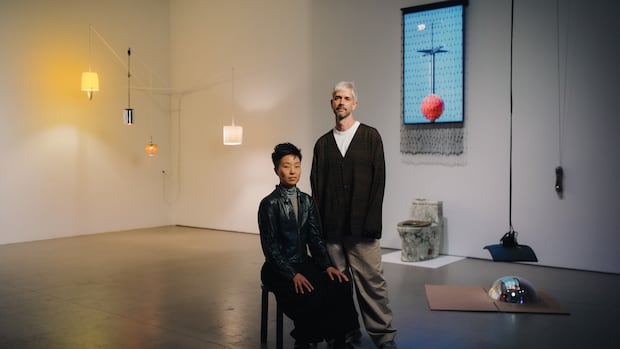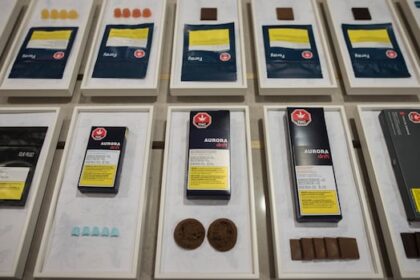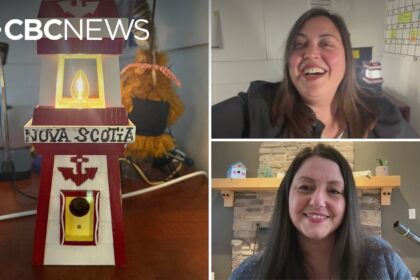ArtsDartmouth, N.S.-based duo HaeAhn Paul Kwon Kajander’s new exhibition, How Is Where You Are, explores identity and lineage using everyday objects. It’s on view now at Mercer Union in Toronto.Used electronics and domestic appliances are all sculptural mediums for HaeAhn Paul Kwon KajanderMacenzie Rebelo · CBC Arts · Posted: Oct 28, 2025 3:42 PM EDT | Last Updated: 7 hours agoListen to this articleEstimated 5 minutesHaeAhn Kwon and Paul Kajander, collectively known as HaeAhn Paul Kwon Kajander, in front of their exhibit How Is Where You Are (Vuk Dragojevic)After being struck by a vehicle while completing her graduate degree in 2018, artist HaeAhn Woo Kwon found herself unable to live, or work, as she had previously. A brain injury resulting from the crash meant she needed help organizing her ideas and tasks in order to keep her art practice afloat.So she asked her life partner, artist Paul Kajander, to help out.While the two had occasionally worked together before, they had always maintained separate artistic practices. They quickly discovered that working as a unit artistically made for a “much more exciting, nourishing and sustainable experience,” says Kajander.The Dartmouth, N.S.-based artists combined their artistic practices into one, HaeAhn Paul Kwon Kajander, and started working exclusively as a duo in 2024.By combining their given names, the pair playfully challenge the idea of identity and how it can be created or reshaped. This is also the motivation behind their first solo institutional exhibition, How Is Where You Are, now at Mercer Union, a centre for contemporary art in Toronto.From HaeAhn Paul Kwon Kajander’s exhibition How is Where You Are. (Vuk Dragojecvic)Inspired by their respective heritages — Finnish and English for Kajander, and Korean for Kwon — and an interest in found objects like old furniture, How Is Where You Are explores ideas around identity and asks viewers to re-examine the objects that are “ubiquitous in our lives,” says Kajander.A hand-painted motif decorates the entrance to the exhibition and pays tribute to Kajander’s grandmother on his father’s side. She fled the republic of Karelia during the 1939 Winter War, when the former Soviet Union invaded Finland. She settled in a rural area on Vancouver Island and painted her own ceiling in a similar way.“We have always been interested in the idea of the makeshift,” says Kajander. “We wanted to consider those direct connections to objects and material histories, where inventive uses arise from the creative repurposing of available means.” The exhibition consists of a four-channel video installation, accompanied by sculptures made out of found objects from everyday life, such as plastic buckets, coffee tins, and cardboard boxes. From HaeAhn Paul Kwon Kajander’s exhibition How is Where You Are. (Vuk Draogjevic)The first work features a boat seat mounted on the wall, appearing to float. At its centre, an air sickness bag holds a cellphone that continuously plays a looping video of one of the striped obelisks that marks the borders of Finland, filmed at Helsinki Airport. (The airport, while not technically a border, still gets an obelisk because it’s an entry point.) Kajander explains the obelisk itself was a found object that interested them, as it’s “a symbolic representation of entering Finland.”Another piece treats a yellowing 1980s fridge door as a canvas, displaying a video at its centre, almost like a large glorified magnet. The video is of an egg and a roll of toilet paper tossed down the prime meridian line at the Royal Conservatory in Greenwich, U.K. Kwon sees the prime meridian as a mark of imperial ambition, located in what appears to be an otherwise unremarkable place.“It measures distances east and west from a fixed point in space, setting London as the centre. But it also points to this arbitrariness that we often think is so determined and absolute,” says Kwon. “This relationship between randomness and specificity was something we thought about during the installation process.”Kwon, who was born and raised in South Korea, explains that because a fridge is connected to food, the piece also symbolizes the ideas of home, taste and language.From HaeAhn Paul Kwon Kajander’s exhibition How is Where You Are. (Vuk Dragojevic)“For Asian people, the smell or the flavour of rice brings you viscerally back home,” she says. “The tongue holds a profound connection to one’s foundational experiences in the language or food of one’s home, yet it can also accommodate new flavours or new languages.” An audio track harmonizes with the four-channel installation, overlaying the sounds of a metronome ticking, fuzzy airport announcements, a fighter jet, Halifax’s noon gun and a Duolingo notification chime. These sounds were chosen with the intent to create a sense of time passing and familiarity.The duo are inspired by the small, easily overlooked moments and actions that make up everyday life — and believe it is simple things that most influence how we see ourselves and connect to others. Kajander explains that not understanding Finnish encouraged him to discover and explore new ways to communicate with his grandmother. The Finnish motifs in his work not only pay tribute to her, but also serve as a love letter to their unique relationship and their improvised methods of communication. Similarly, the sculptures of How Is Where You Are engage audiences in unexpected ways, inviting viewers to rediscover and redefine home and identity through sculpture and art. “We are communicating in this other way,” says Kajander. How Is Where You Are runs until Jan. 17, 2026 at Mercer Union (1286 Bloor St. W.) in Toronto. ABOUT THE AUTHORMacenzie is an arts and culture journalist based in Toronto.
What does this fridge door say about me? Dartmouth duo explores how identity is bound up in everyday objects











